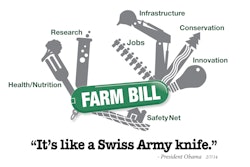
Since even before the Food Safety Modernization Act, traceability has been a buzzword around the feed and grain industries. After all, whether your feed mill is a family-owned individual facility or a nationwide company with dozens of plants, the industry as a whole has to deal with possible recalls and government mandated record keeping no matter the level. It is just part of doing business.
“Traceability software works in the background,” said Art Peters, manager of automation at Comco. “It’s not something our customers use on a daily basis. It’s there for a recall or government visit. But it also offers customers things like what we call costing. With costingclients can figure out what went into the mix, how much those ingredients cost and how much they should charge for it.”
This combination of “want” and “need” has created a demand that has allowed software providers to craft new and innovative solutions. They have found that the ability to track commodities, feed additives and finished product as it moves through the facility and gets delivered to customers, yields advantages far beyond simple record keeping for government regulation. By looking at what they have to offer, companies can determine what their facilities need and how best to obtain it.
Better than first in first out
For years the only real way to track the ingredients being pulled from a bin was through first in first out (FIFO). Still a common method today, many feed mill employees know the system intimately. FIFO involves simply tracking how much is put into a bin when raw materials are taken in, then tracking what is taken out during manufacturing. This allows facilities to estimate what load is currently on the bottom of the bin and the were bin ingredients came from in any particular mix. It also involves binders and binders of paperwork or spreadsheets that need to be matched up, and countless opportunities for human error, from matching the wrong information to simply inputting a wrong number.
The automation provided by traceability software solves most of those issues, but it also takes into account someone doing FIFO by hand will never be able to account for: coning in.
“Many in the market are tracking lots in a first in first out process, assuming that the bin will go down close to even, but as we know in the industry, bins ‘cone in,’ mixing lots,” explained Chris Gaalswyk, president of Easy-Automation.
“Coning in” happens when grain is center drawn from the bottom of a bin, creating a funnel that draws grain from every layer in the bin. The moment grain is drawn from a bin it becomes mixed, and the only way to guarantee what load of grain is being used in any individual product is to completely empty and clean out the bin. Today’s traceability software uses algorithms to more precisely measure the amount of mixing happening within the tank.
“You can have a bin with all
15% protein, with just one layer of 13% protein in the middle,” said Marcus Butterfield, programmer at Vertical Software, Inc. “By knowing exactly what is in the bin, companies can know what the quality will be when the draw from it.”
Record keeping
Visits from local and federal regulators can eat up a lot of a staff’s time — not only from the visits from the regulators themselves, but also the need to be prepared for when one does stop by.
“There are mills out there that don’t yet have automation, but have an interest in getting automated because of the traceability that can come with it,” said Peters. “Even if they don’t need traceability, they want it in order to stay future proof.”
可追溯性还可以防止人为错误。通过the use of bar codes and other scanning technology, the systems can alert employees when the wrong ingredient is being added, or when a delivery mistake is about to be made.
“One of the reasons our customers are getting our software, is that orders were being delivered to the wrong farms,” explained Alan Berndtson, dirctor of sales, WEM Automation, Inc. “The farm would have animals getting ready to get slaughtered being fed medicated feed that would end up delaying the slaughter date. Our software uses bar codes on products that are scanned when they get delivered to nullify these mistakes.”
Recalls
No company wants to issue a recall. Not only does it erode customer confidence, but it also costs a great deal of money and man power. Knowledge is paramount during a recall situation. It can mean the difference between having to take back a month’s worth of mix, or just a single batch. The information traceability products offer can also save a facility manager late nights rummaging through paperwork.
“Digging through piles of tickets and reports and trying to add up all the threads generate a great deal of stress for a manager during a recall,” said Gaalswyk. “We’ve found that one of the most common benefits with our traceability software is the ability to get realtime reports. They can be used during recalls, audits or even just for peace of mind.”
So when something goes wrong, it will know exactly how much of the product is affected, where it came from and where it went.
The solution is out there
The Food and Drug Administration’s Food Safety Modernization Act is hurdling toward the industry, threatening mountains of paperwork and more government inspections. Traceability programs can automate it, taking much of this work out of the hands of mill and elevator personnel. This has put traceability on the top of the industry’s wish list, and the companies that provide the tools are happy to comply.
“FSMA is a buzzword right now throughout the industry,” said Butterfield “It’s made people far more aware of traceability and the need for it.”
Most of the companies interviewed for this article offer solutions for both mill and front office record keeping. They offer programs for every level of need, and every type of facility, whether brand-new or being retrofitted for the first time. These solutions can turn binders of paperwork into simple data with programs that allow a manager to see their facility’s workings with just the click of a mouse. Traceability is just one of the tools that can be added to a manger’s repertoire to increase the overarching goal of being more efficient, safe and cost-effective.
“Traceability is a system that ties everything in a facility together,” explained Berndtson. “It should be part of, and can help with lot tracking, material confirmation, the manufacturing process and delivery confirmation. In the end, they all work into a facility’s best management practices.”

.jpg?auto=format%2Ccompress&crop=faces&fit=crop&h=48&q=70&w=48)




















